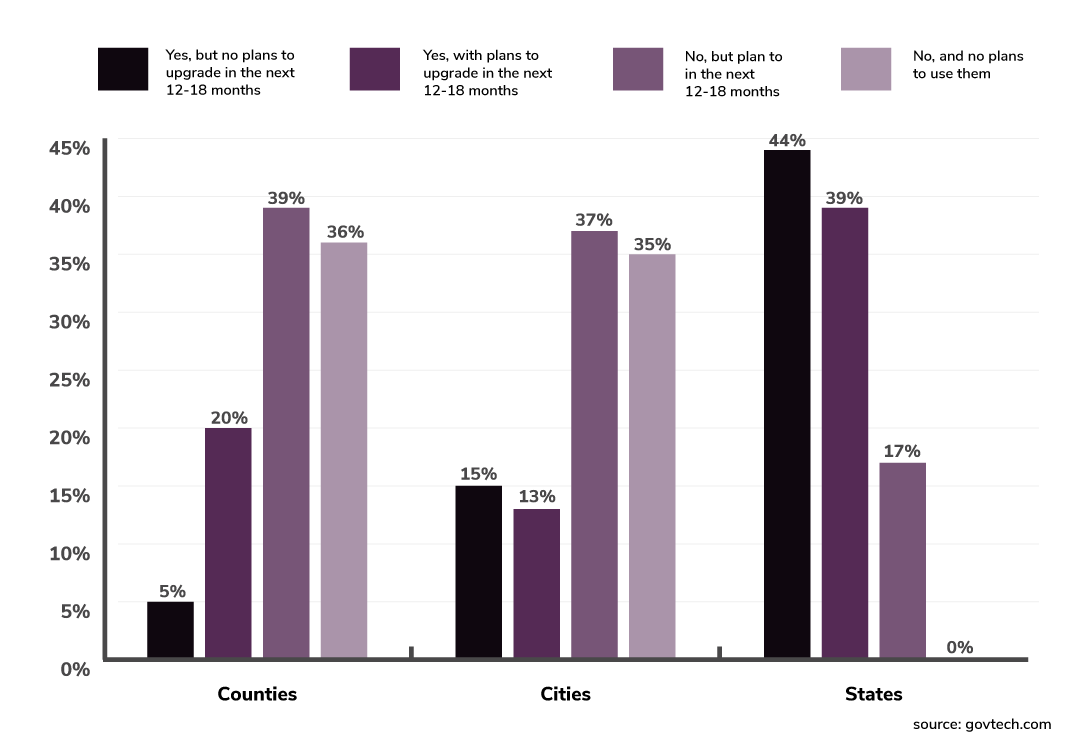The 2022 Center for Digital Government Surveys revealed that the coronavirus pandemic pushed many states, counties and cities from all over the world to quickly embrace emerging technologies.
One of the best examples of this is chatbots using artificial intelligence to give prompt and detailed answers to citizens’ questions and relieving overworked human staff from repetitive tasks.
What is a chatbot, exactly?
Chatbots are software designed to serve as virtual assistants, helping people find quick answers to their questions. However, the technology used for basic chatbots is limited and can only answer predefined queries based on FAQs or basic information shared by human support.
Fortunately, public sector institutions have begun to make use of conversational artificial intelligence features to improve their chatbot's comprehension. These 'synthetic brains' allow them to understand their users’ inquiries more effectively and deliver answers capable of higher levels of complex understanding than basic chatbots - making the entire communication process smoother while simultaneously increasing efficiency. While not all chatbots are powered by this type of solution, government chatbots have generally witnessed a better user experience overall.
What are chatbots’ benefits for the public sector?
In 2020, the pandemic led to a substantial surge in the dependence on government services. Visits to government websites reached unprecedented levels as citizens, unable to access physical offices, increasingly turned to digital channels for services such as health testing, unemployment benefits, and various forms of assistance.
While many national, regional, or local services were initially unprepared for the overwhelming influx of requests, they have since embraced, or are in the process of embracing, solutions to accommodate the needs of their users.
Chatbots are one of the best ways to facilitate public sector user support:
- Increasing support service capacity and getting faster response times to inquiries.
- Improving access to information (which can be particularly useful for people living in remote or underserved areas or looking for assistance outside of normal working hours).
- Reducing the need for human support staff, by providing customer self-service with automated responses to most common inquiries.
- Improving data collection and analysis, enabling government services in understanding their users needs and preferences.
- Providing clearer answers to users, without any risk of mistake or misunderstanding from a human conversation.
- Keeping human operators from becoming demotivated by recurrent questions, keeping their attention focused on more complicated/interesting cases and limiting their churn.
Chatbots benefits for government services are undeniable: these solutions can help any national, regional or local services to boost their productivity and efficiency but what are the challenges to face when opting for them? Let’s find out…
Challenges of implementing chatbots for government services:
According to govtech.com, 64% of counties, 65% of cities and 100% of states in the US are planning to implement chatbot solutions in the next months :

These adoptions come with two different kinds of challenges, challenges that support service managers will need to face before, during and after the integration process:
Technical complexity:
Governments need to consider many elements when deploying chatbots.
Building and integrating chatbots into existing government systems can be technically challenging, requiring specialized skills and resources for integration, training and maintenance. Most of the time, opting for a no code chatbot solution is good way to make sure any user, from developers to customer support members, avoids problems during the integration and deployment phases.
Furthermore, governments services, often dealing with personal data, must ensure that sensitive information is protected by their solution provider, requesting for instance, an iso 27001 certification, proving the company is able to manage valuable third party information assets.
Finally, public sector services should consider scalability as an important technical criteria before opting for any chatbot solution.
“50% of chatbots adopted by governments are not matching their scalability needs and/or fitting to their specifications”.
Support services evolve. Needs, applications and system processing often change.
Any chatbot should be able to evolve as well, matching with any new situation.
As bringing new features to existing solutions is often expensive and, sometimes not even possible, opting for a new chatbot is a common solution for government services.
Public Reaction:
Public trust is an essential element of chatbots, but citizens may be hesitant to accept their information as reliable. The accuracy of these systems must be closely considered when deciding how best to engage users. Checking to ensure chatbot accuracy should be a priority.
If chatbots may be a helpful addition to government agencies, the lack of transparency of some of them and accountability that citizens require could lead to failure. Government services must ensure their solution provides an adequate level of openness for them to satisfy the public’s needs.
Finally, ensuring that chatbots can be used by citizens in multiple languages and are accessible to people with disabilities can be a challenge. Remember that even in a same country, different languages may be spoken by different populations:
- English is not the main language for 22% of Americans.
- Only 40% of Belgian population speaks French (against 60%, Dutch).
Some chatbot solutions, such as boost.ai, use conversational AI for decoding complex languages and bring clear, transparent and accurate information to citizens.
Here are some good examples to follow…
Successful government chatbot implementations:
With 30% reduction in phone calls and emails…
57% of inquiries outside of opening hours…
And 85% satisfaction rates on answers…
Discover how some city services integrated their chatbot and how the benefited from it with:
- Roskilde Municipality (DK).
- City of Riihimaki (FIN).
- Sodertalje Municipality (SWE).
2023 to 2025 - Onboarding voice chatbot features:
With recent advances in voicing algorithms, support services are now even able to onboard voice bots solutions to their contact center.
A voice bot is a type of chatbot that interacts with users using voice commands and natural language processing (NLP) technology. Unlike text-based chatbots, which rely on users typing out their inquiries or requests, voice bots allow users to converse with the bot using spoken language.
Like their text counterparts, voice bots can be used to provide information, answer questions, make recommendations and perform a variety of tasks, such as booking appointments with city officials or getting information about some services' opening hours.
Learn more, listening to some AI voice bot conversations.
